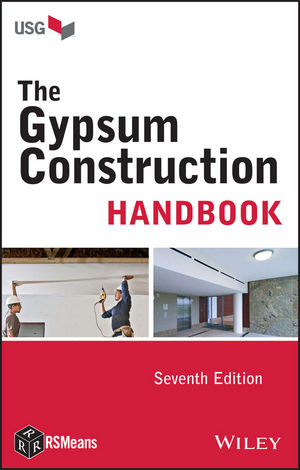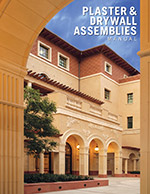Veneer plaster, as the name suggests, consists of a thin membrane of plaster that is applied to any of several substrates. The most common substrate for veneer plaster, but by no means the only one, is a gypsum panel product known as gypsum base for veneer plaster or in the vernacular “blueboard,” so called because of its blue-colored facing paper.
Gypsum veneer plaster systems offer many positive features. They provide a durable, hard surface that resists scuffing, denting, cracking, and abrasion and, since they set hard in a few hours, are ready to decorate the next day under proper drying conditions. They can be integrally colored with pigments and worked using various finishing techniques to create an intentionally textured surface. Two-coat applications offer improved aesthetics where indirect lighting conditions exist or when high gloss paint is specified.
In other words, a veneer plaster system provides many of the advantages of a traditional plaster system-abrasion and scuff resistance, high quality appearance, fire-resistance-with the speed of construction and economy of a regular gypsum wallboard system. The materials for both one- and two-coat systems are available pre-measured in bags, ready to mix with potable water on the job site. Under proper drying conditions, the setting time of veneer plaster materials is generally between 45 and 90 minutes. So, with sufficient manpower, a one-coat application can be completed, from bare studs to decoration, in only 48 to 72 hours.
Since veneer plaster systems first appeared in the 1950s, their formulations have been steadily refined to the point that today they are easily mixed and applied to produce a high-quality finish that is only 1/16 to 3/32 inch thick, yet still meets the most stringent of performance requirements. The key to getting optimal performance out of veneer plaster systems is careful adherence to proper mixing time, application techniques and the final trowel finishing. Most products require the use of high-speed mechanical mixers to properly combine all the ingredients; the plasters come complete in their bags, so unless the manufacturer specifically states that something may be added, one must never alter the mix to ensure that proper application and performance properties of the plaster are achieved.
Likewise, manufacturers’ instructions on the use of water must be strictly followed to ensure proper mixing and setting. Setting times on these products can be quite short; thorough mixing is essential to providing the applicator with a workable material.
To ensure that the products used in veneer plaster systems perform as expected, they are manufactured to meet ASTM C 587, “Standard Specification for Gypsum Veneer Plaster” and ASTM C 588, “Standard Specification for Gypsum Base for Veneer Plasters.”
TWO VENEER PLASTER SYSTEM TYPES
Veneer plasters are available in one-component and two-component systems. A one-component gypsum veneer plaster is mixed with water and applied into a single thin coat. The standard method for this type of application is referred to as the “scratch and double back” method. In such an application, the first pass of the material is allowed to begin to set, receives a scratching with either a broom or rake to provide tooth for the second pass, and before it completely sets, receives the second pass. The intended thickness for this type of application is 1/16 to 3/32 inch. And though this type of system is usually applied over blueboard, particularly when a smooth finish is required, it is quite adaptable for use over unit masonry and concrete when properly prepared.Skilled finishers can achieve any number of looks in this material using different finishing tools and adding sand or other aggregates; however, different manufacturers offer a wide selection of products for specific looks or applications, so one must consult and comply with the manufacturer’s specifications to get the desired results.
Two-component gypsum veneer plaster systems use separate basecoat and finish coat materials. The basecoat plaster in these systems is much stronger than conventional plaster. Once applied over the substrate, it can receive the finish coat approximately two hours after it has set, or once proper “suction” has been reached. This system works particularly well over masonry block surfaces since it can be used to level out minor irregularities in those surfaces. The finish coat in these systems may also be finished to smooth or textured profiles.
While much veneer plaster is hand-applied using traditional trowel methods, there are also specially formulated veneer plaster mixes for machine application. Timing is very critical when using a machine to apply these fast-setting materials, since sufficient time must be allowed to both spray the material and clean the machine between batches to ensure even setting. The basecoat of machine-applied plaster is sprayed in two passes at right angles. For example the first pass may be floor to ceiling, and the second pass is side to side. Depending on the texture desired, the finish coat is either hand- or machine-applied.
APPLICATION TO BLUE BOARD
As already mentioned, veneer plaster is most frequently applied to gypsum veneer plaster base, or blue board. Blue board is installed following basically the same good practices as are used to install regular wallboard; however, there is a specific standard for its application: ASTM C 844, “Standard Specification of Gypsum Base to Receive Gypsum Veneer Plaster.” Special attention must be given to the steps taken to reinforce the joints prior to the application of the plaster, since the plaster is relatively thin. Likewise, outside corners must be properly reinforced using metal cornerbeads. Based on manufacturer’s recommendations, either paper or mesh tape may be used to reinforce joints.Notably, one specific difference between an installation of regular gypsum wallboard and gypsum veneer base is that the face of veneer base is never dimpled at the fasteners. Fasteners used to install veneer base are always driven flush with the surface of the board and are not depressed.
Following joint reinforcement, the veneer plaster is applied to the board in accordance with manufacturer’s instructions. ASTM C 843, “Standard Specification for Application of Gypsum Veneer Plaster” should also be consulted.
DIRECT APPLICATION TO MASONRY AND CONCRETE SURFACES
Masonry and concrete walls and ceilings can be quickly made into a smoother surface by an application of veneer plaster. Properly installed and treated concrete and masonry surfaces provide an excellent base for the application of veneer plaster. The final appearance of veneer plaster over concrete or masonry will be very similar, if not identical, to that of veneer plaster over gypsum veneer base.Masonry and concrete walls and ceilings should be straight, true, and clean of oil and dirt. Minor surface irregularities should be treated with basecoat plaster as needed, but the overall surface should be allowed to remain sufficiently rough to permit adequate keying of the plaster to the base surface. A bonding compound may have to be installed over smooth-surface concrete systems. The bonding compound should be applied using manufacturer’s instructions. Again, the ASTM C 843 standard should be consulted for specific requirements.
So, when a job calls for a high quality, durable system that goes up quickly and can be decorated the next day, consider a veneer plaster system. For more detail on these systems, download “GA-151, Veneer Plaster” fromwww.gypsum.org.W&C




